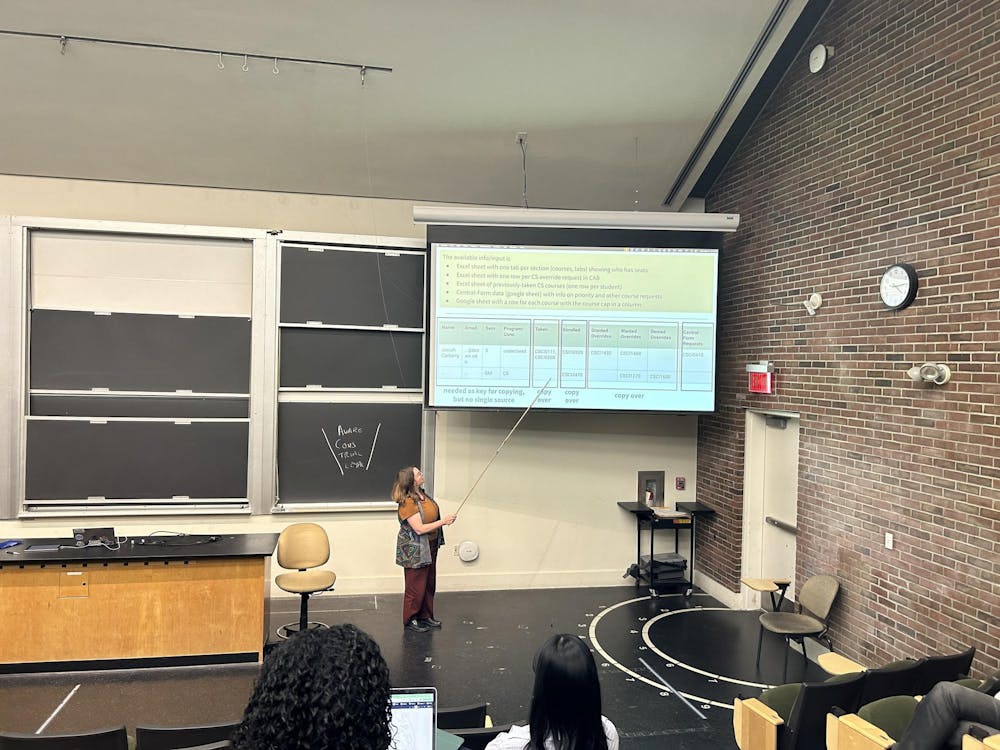The Department of Computer Science hosted an interactive event on Thursday to reflect on and propose improvements to the department’s enrollment process, following challenges earlier in the semester.
The 90-minute event, titled “The CS Enrollment Challenge: a Software Case Study and Future Design,” was directed by Kathi Fisler, co-director of the CS undergraduate program and professor of computer science. The session began with a software case study of the fall enrollment process, followed by an open discussion in which students were asked to share ideas for next semester’s registration.
Last year, the department announced an enrollment cap for most courses starting this semester due to restrictions related to classroom space, budgeting for teaching assistants and course staffing, The Herald previously reported. The department created a centralized pre-registration form to better gauge course demand and allocate seats.
But concentrators and non-concentrators alike still struggled to enroll in pre-requisite and elective courses in the department.
Fisler’s technical case study — attended by about 25 students and a few faculty members — examined how she developed the registration system by merging data from the centralized pre-registration form with registrar-generated data about students’ past and existing course enrollments and override requests.
The event allowed students to see how the new enrollment process “actually got put together,” Fisler said in an interview with The Herald.
Fisler acknowledged that the system did present challenges, including for her. Working with Google Sheets, Fisler said she “was designing this with duct tape and bubble gum to get us through.”
She noted additional challenges with the data. Even though it only takes students seconds to enroll in or drop a course on Courses@Brown, Fisler was only provided with the updated enrollment and override data every 24 hours.
The information compiled in Google Sheets helped faculty decide which students should be given overrides. Any errors in the Google Sheets formulations could have negatively impacted students’ registration.
In the event, Fisler’s experience became a learning opportunity for students. She shared takeaways from her time building the system, such as the process of cleaning up the registrar data to accurately reflect students’ concentrations and preferences.
Looking to the spring, Fisler explained that some CS courses will still have enrollment caps because the department can no longer afford to overspend on TAs for courses that students may end up dropping. CS enrollment will also be capped due to the increasing demand for large classrooms across STEM fields, she explained.
During the brainstorming segment of the session, students proposed a variety of ideas for next semester. These included a lottery system for registration and the implementation of a requirement that students must complete a certain amount of assignments during shopping period to enroll in a course.
One student suggested requiring students to express weighted preferences for courses.
“We consider things like that,” Fisler responded. “We have to get all of you into the mindset that says, ‘I am willing to make some decisions in pre-registration instead of waiting for shopping period. And I think there’s that cultural friction that we have to figure out how to work with.”
The event made CS registration “less of a black box for us,” Melvin He ’25, a CS concentrator that attended the event, said in an interview with The Herald.
While He is still worried about spring registration, the event left him more hopeful that the department will “improve on things that went wrong,” he said.
Fisler noted that the department is “under time pressure.” The undergraduate TA hiring process for next semester has already begun — which impacts how many students a course can accommodate — and pre-registration is coming up in November.
“This is new territory for everybody,” Fisler told The Herald, adding that the department is trying to keep students as informed as possible throughout the process.
“There’s no simple solution to this, since we can't go back to the old system,” she said. “So it’s a question of figuring out what’s the best thing we can do that works for as many folks as possible and doesn't leave anybody out.”

Kate Rowberry is a senior staff writer at The Herald.





